Leadership Model: A Comprehensive Analysis of Organizational Success
VerifiedAdded on 2020/05/16
|9
|2084
|148
Essay
AI Summary
This essay delves into a comprehensive leadership model designed to foster organizational success. The model emphasizes the crucial interplay of power, teamwork, and relationship building, highlighting how these elements contribute to effective leadership. It explores the significance of power in influencing employees, the necessity of teamwork for problem-solving and production, and the importance of strong relationships between leaders and their teams. The model advocates for a shift from power-driven to relationship-driven leadership styles, empowering leaders to foster empathy and create strong, productive teams. It outlines essential leadership traits such as strong communication, adaptability, and a commitment to employee development, alongside core values like respect, ethical conduct, and a focus on the common good. The essay further outlines the model's aims, including building collaborative teams, inspiring motivation, and providing clear guidelines, as well as the benefits of increased employee engagement, adaptability to change, and a cohesive organizational culture built on mutual trust. The model's uniqueness lies in its combination of power and relationship-driven approaches, offering a fresh perspective on leadership applicable to various organizational contexts. The essay concludes by emphasizing the model's potential to address organizational challenges through the development of a strong and versatile team, providing a detailed analysis of its ideology, benefits, and core values.
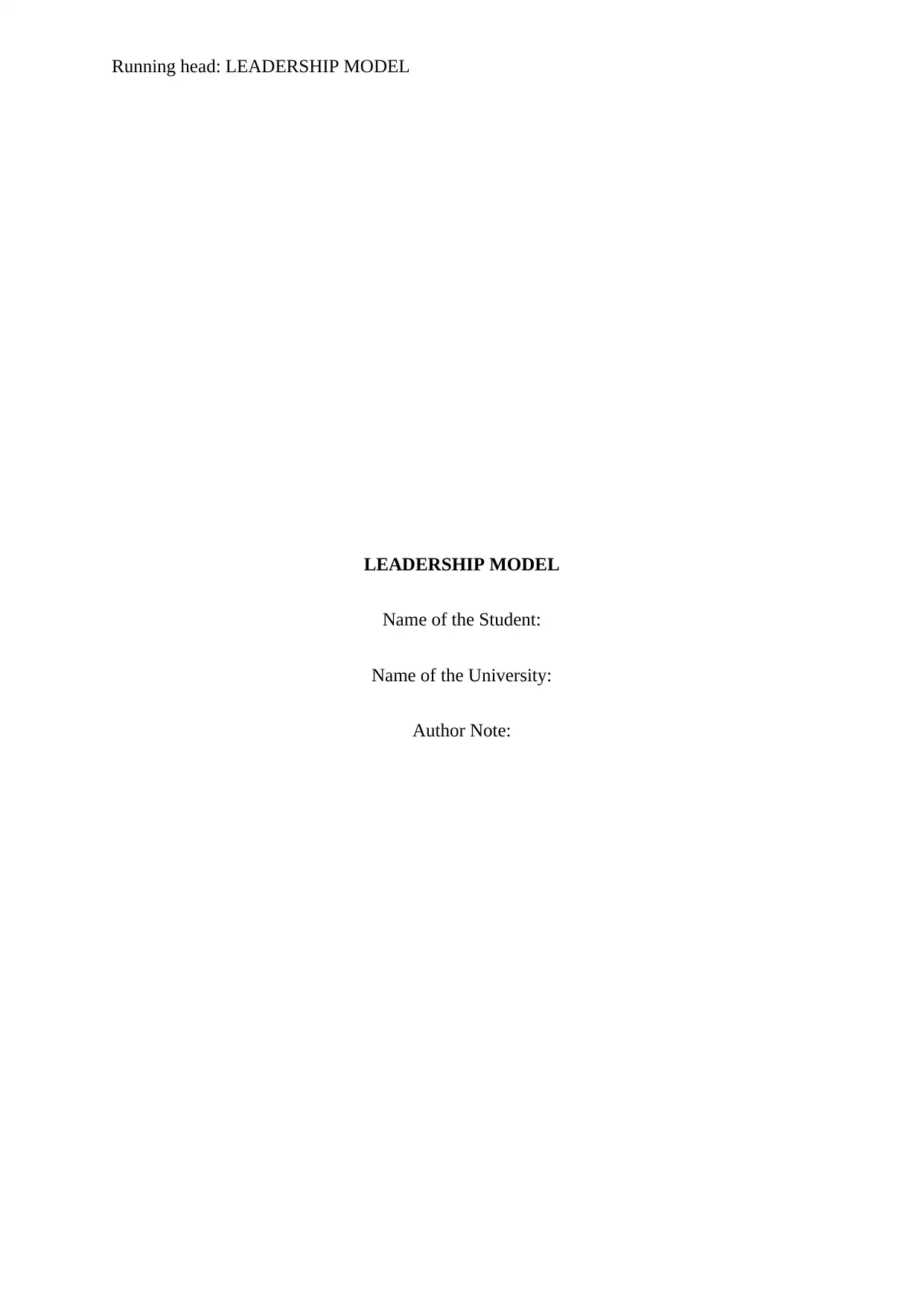
Running head: LEADERSHIP MODEL
LEADERSHIP MODEL
Name of the Student:
Name of the University:
Author Note:
LEADERSHIP MODEL
Name of the Student:
Name of the University:
Author Note:
Paraphrase This Document
Need a fresh take? Get an instant paraphrase of this document with our AI Paraphraser
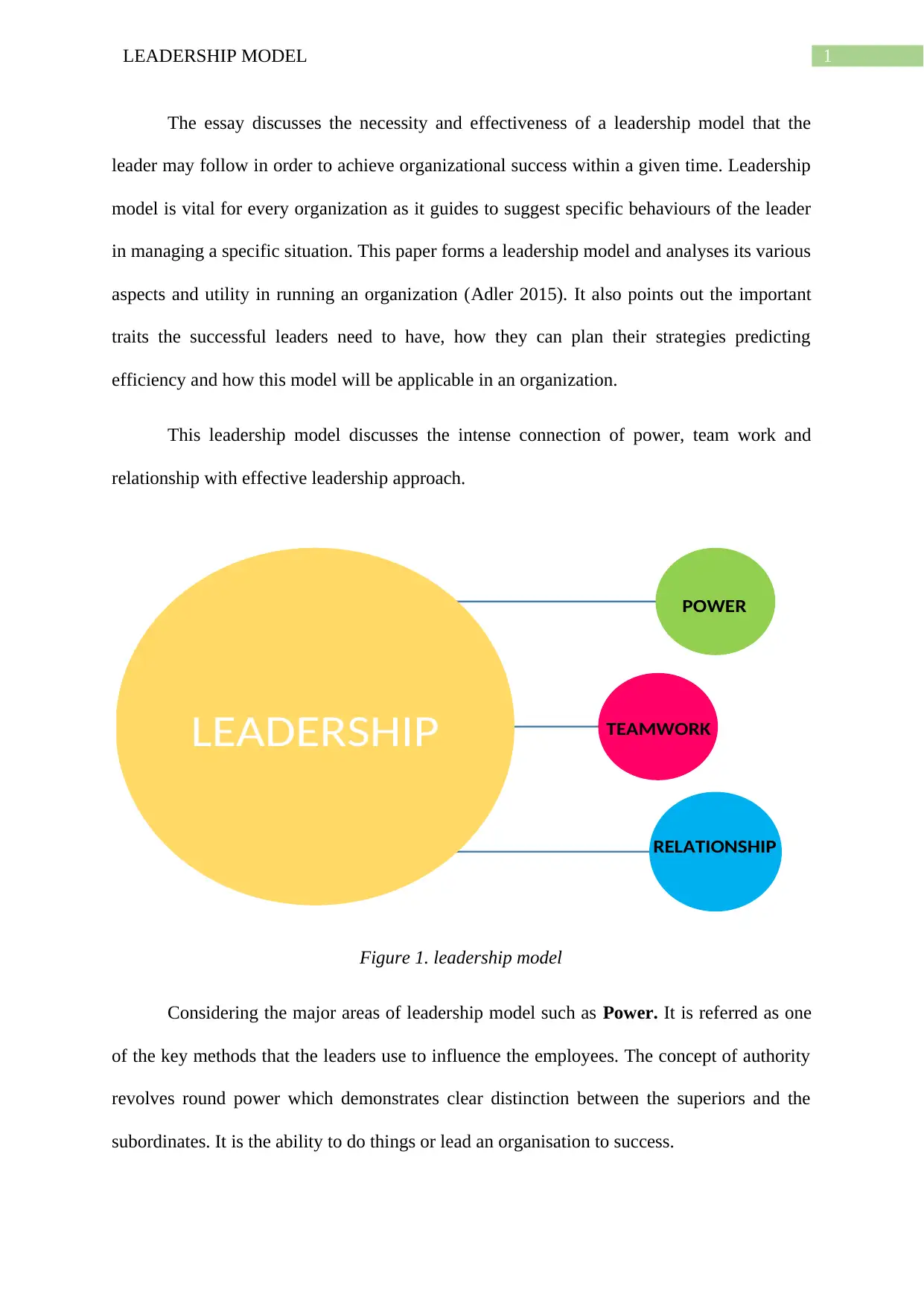
1LEADERSHIP MODEL
The essay discusses the necessity and effectiveness of a leadership model that the
leader may follow in order to achieve organizational success within a given time. Leadership
model is vital for every organization as it guides to suggest specific behaviours of the leader
in managing a specific situation. This paper forms a leadership model and analyses its various
aspects and utility in running an organization (Adler 2015). It also points out the important
traits the successful leaders need to have, how they can plan their strategies predicting
efficiency and how this model will be applicable in an organization.
This leadership model discusses the intense connection of power, team work and
relationship with effective leadership approach.
Figure 1. leadership model
Considering the major areas of leadership model such as Power. It is referred as one
of the key methods that the leaders use to influence the employees. The concept of authority
revolves round power which demonstrates clear distinction between the superiors and the
subordinates. It is the ability to do things or lead an organisation to success.
LEADERSHIP
POWER
TEAMWORK
RELATIONSHIP
The essay discusses the necessity and effectiveness of a leadership model that the
leader may follow in order to achieve organizational success within a given time. Leadership
model is vital for every organization as it guides to suggest specific behaviours of the leader
in managing a specific situation. This paper forms a leadership model and analyses its various
aspects and utility in running an organization (Adler 2015). It also points out the important
traits the successful leaders need to have, how they can plan their strategies predicting
efficiency and how this model will be applicable in an organization.
This leadership model discusses the intense connection of power, team work and
relationship with effective leadership approach.
Figure 1. leadership model
Considering the major areas of leadership model such as Power. It is referred as one
of the key methods that the leaders use to influence the employees. The concept of authority
revolves round power which demonstrates clear distinction between the superiors and the
subordinates. It is the ability to do things or lead an organisation to success.
LEADERSHIP
POWER
TEAMWORK
RELATIONSHIP
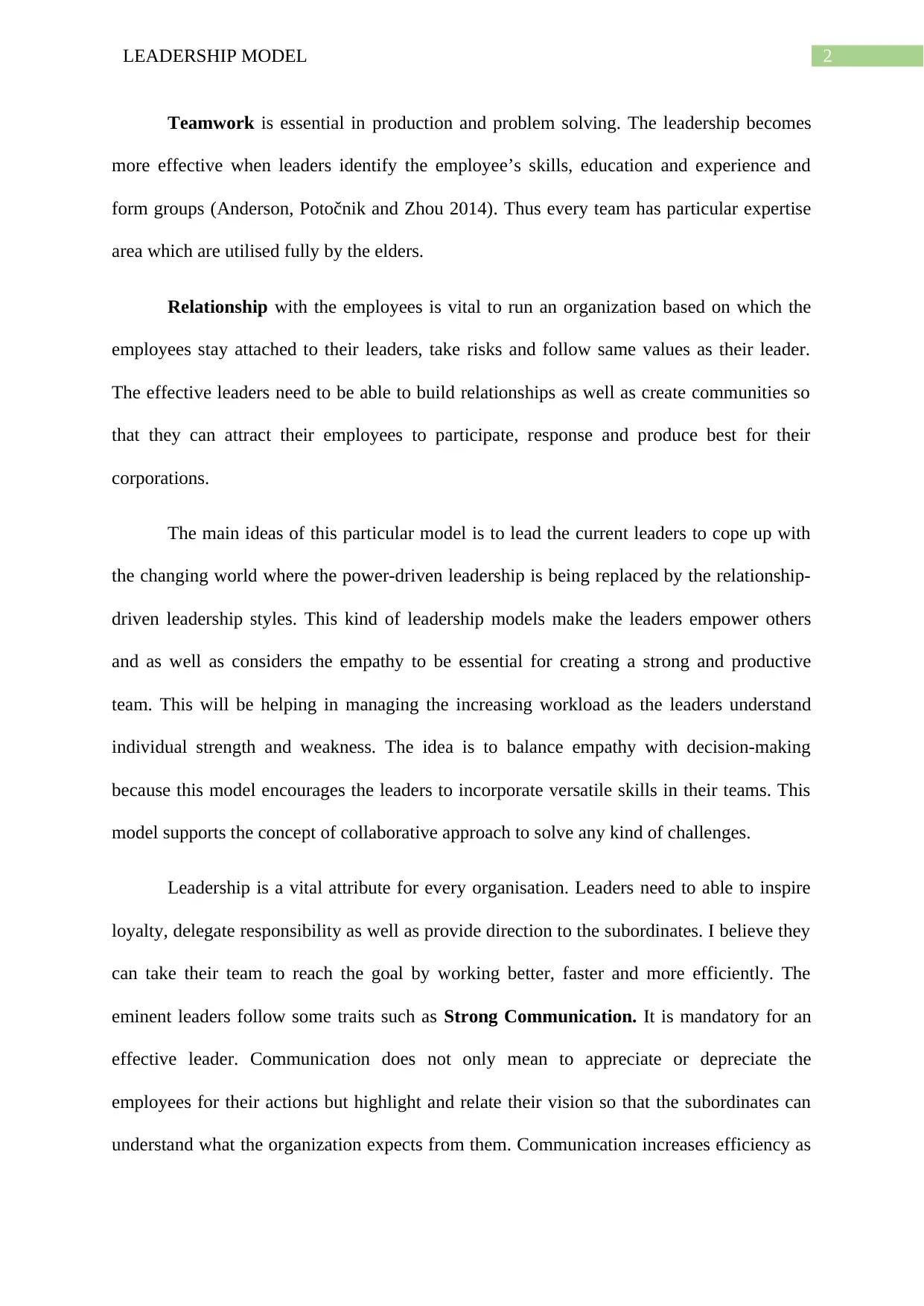
2LEADERSHIP MODEL
Teamwork is essential in production and problem solving. The leadership becomes
more effective when leaders identify the employee’s skills, education and experience and
form groups (Anderson, Potočnik and Zhou 2014). Thus every team has particular expertise
area which are utilised fully by the elders.
Relationship with the employees is vital to run an organization based on which the
employees stay attached to their leaders, take risks and follow same values as their leader.
The effective leaders need to be able to build relationships as well as create communities so
that they can attract their employees to participate, response and produce best for their
corporations.
The main ideas of this particular model is to lead the current leaders to cope up with
the changing world where the power-driven leadership is being replaced by the relationship-
driven leadership styles. This kind of leadership models make the leaders empower others
and as well as considers the empathy to be essential for creating a strong and productive
team. This will be helping in managing the increasing workload as the leaders understand
individual strength and weakness. The idea is to balance empathy with decision-making
because this model encourages the leaders to incorporate versatile skills in their teams. This
model supports the concept of collaborative approach to solve any kind of challenges.
Leadership is a vital attribute for every organisation. Leaders need to able to inspire
loyalty, delegate responsibility as well as provide direction to the subordinates. I believe they
can take their team to reach the goal by working better, faster and more efficiently. The
eminent leaders follow some traits such as Strong Communication. It is mandatory for an
effective leader. Communication does not only mean to appreciate or depreciate the
employees for their actions but highlight and relate their vision so that the subordinates can
understand what the organization expects from them. Communication increases efficiency as
Teamwork is essential in production and problem solving. The leadership becomes
more effective when leaders identify the employee’s skills, education and experience and
form groups (Anderson, Potočnik and Zhou 2014). Thus every team has particular expertise
area which are utilised fully by the elders.
Relationship with the employees is vital to run an organization based on which the
employees stay attached to their leaders, take risks and follow same values as their leader.
The effective leaders need to be able to build relationships as well as create communities so
that they can attract their employees to participate, response and produce best for their
corporations.
The main ideas of this particular model is to lead the current leaders to cope up with
the changing world where the power-driven leadership is being replaced by the relationship-
driven leadership styles. This kind of leadership models make the leaders empower others
and as well as considers the empathy to be essential for creating a strong and productive
team. This will be helping in managing the increasing workload as the leaders understand
individual strength and weakness. The idea is to balance empathy with decision-making
because this model encourages the leaders to incorporate versatile skills in their teams. This
model supports the concept of collaborative approach to solve any kind of challenges.
Leadership is a vital attribute for every organisation. Leaders need to able to inspire
loyalty, delegate responsibility as well as provide direction to the subordinates. I believe they
can take their team to reach the goal by working better, faster and more efficiently. The
eminent leaders follow some traits such as Strong Communication. It is mandatory for an
effective leader. Communication does not only mean to appreciate or depreciate the
employees for their actions but highlight and relate their vision so that the subordinates can
understand what the organization expects from them. Communication increases efficiency as
⊘ This is a preview!⊘
Do you want full access?
Subscribe today to unlock all pages.

Trusted by 1+ million students worldwide
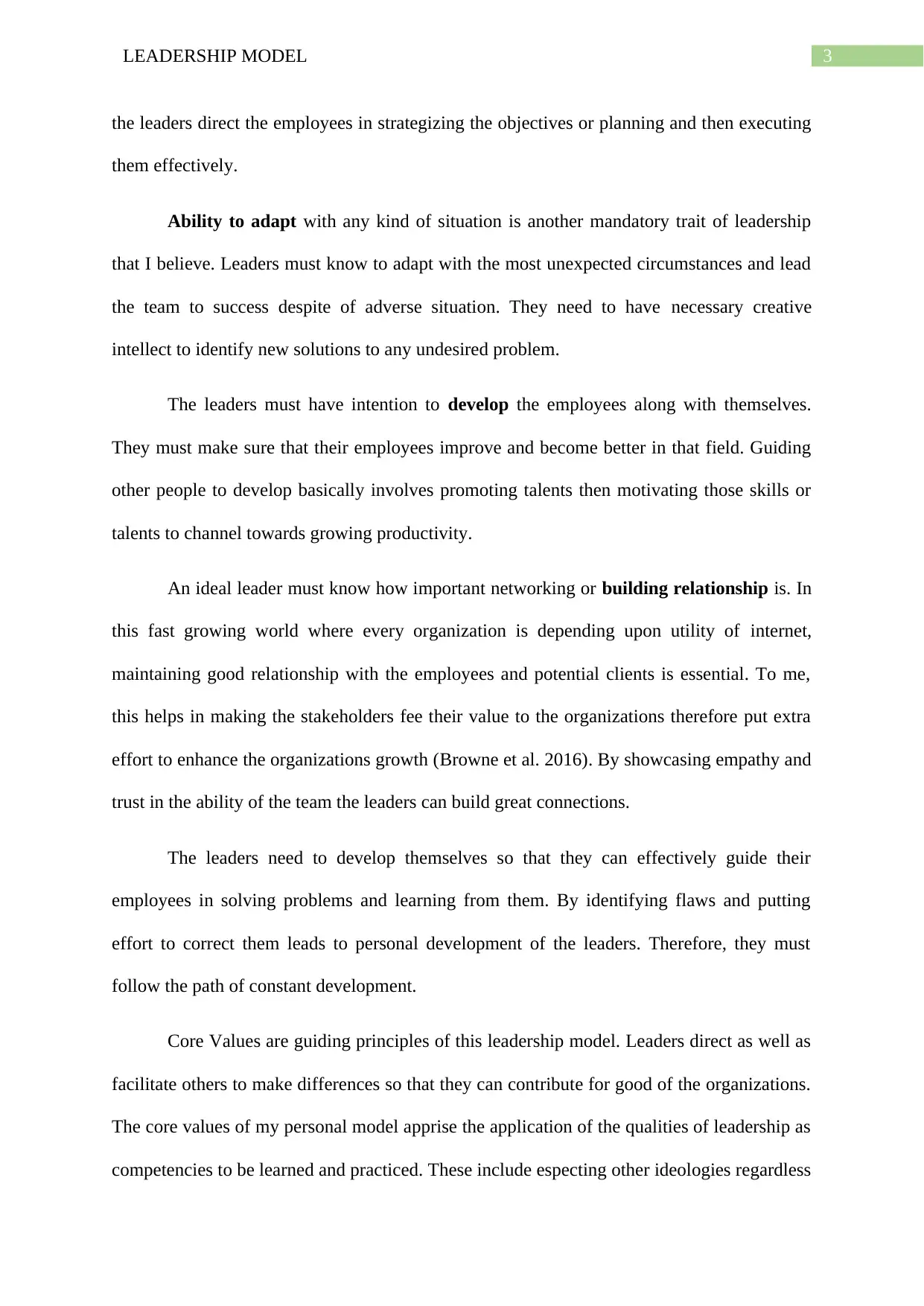
3LEADERSHIP MODEL
the leaders direct the employees in strategizing the objectives or planning and then executing
them effectively.
Ability to adapt with any kind of situation is another mandatory trait of leadership
that I believe. Leaders must know to adapt with the most unexpected circumstances and lead
the team to success despite of adverse situation. They need to have necessary creative
intellect to identify new solutions to any undesired problem.
The leaders must have intention to develop the employees along with themselves.
They must make sure that their employees improve and become better in that field. Guiding
other people to develop basically involves promoting talents then motivating those skills or
talents to channel towards growing productivity.
An ideal leader must know how important networking or building relationship is. In
this fast growing world where every organization is depending upon utility of internet,
maintaining good relationship with the employees and potential clients is essential. To me,
this helps in making the stakeholders fee their value to the organizations therefore put extra
effort to enhance the organizations growth (Browne et al. 2016). By showcasing empathy and
trust in the ability of the team the leaders can build great connections.
The leaders need to develop themselves so that they can effectively guide their
employees in solving problems and learning from them. By identifying flaws and putting
effort to correct them leads to personal development of the leaders. Therefore, they must
follow the path of constant development.
Core Values are guiding principles of this leadership model. Leaders direct as well as
facilitate others to make differences so that they can contribute for good of the organizations.
The core values of my personal model apprise the application of the qualities of leadership as
competencies to be learned and practiced. These include especting other ideologies regardless
the leaders direct the employees in strategizing the objectives or planning and then executing
them effectively.
Ability to adapt with any kind of situation is another mandatory trait of leadership
that I believe. Leaders must know to adapt with the most unexpected circumstances and lead
the team to success despite of adverse situation. They need to have necessary creative
intellect to identify new solutions to any undesired problem.
The leaders must have intention to develop the employees along with themselves.
They must make sure that their employees improve and become better in that field. Guiding
other people to develop basically involves promoting talents then motivating those skills or
talents to channel towards growing productivity.
An ideal leader must know how important networking or building relationship is. In
this fast growing world where every organization is depending upon utility of internet,
maintaining good relationship with the employees and potential clients is essential. To me,
this helps in making the stakeholders fee their value to the organizations therefore put extra
effort to enhance the organizations growth (Browne et al. 2016). By showcasing empathy and
trust in the ability of the team the leaders can build great connections.
The leaders need to develop themselves so that they can effectively guide their
employees in solving problems and learning from them. By identifying flaws and putting
effort to correct them leads to personal development of the leaders. Therefore, they must
follow the path of constant development.
Core Values are guiding principles of this leadership model. Leaders direct as well as
facilitate others to make differences so that they can contribute for good of the organizations.
The core values of my personal model apprise the application of the qualities of leadership as
competencies to be learned and practiced. These include especting other ideologies regardless
Paraphrase This Document
Need a fresh take? Get an instant paraphrase of this document with our AI Paraphraser
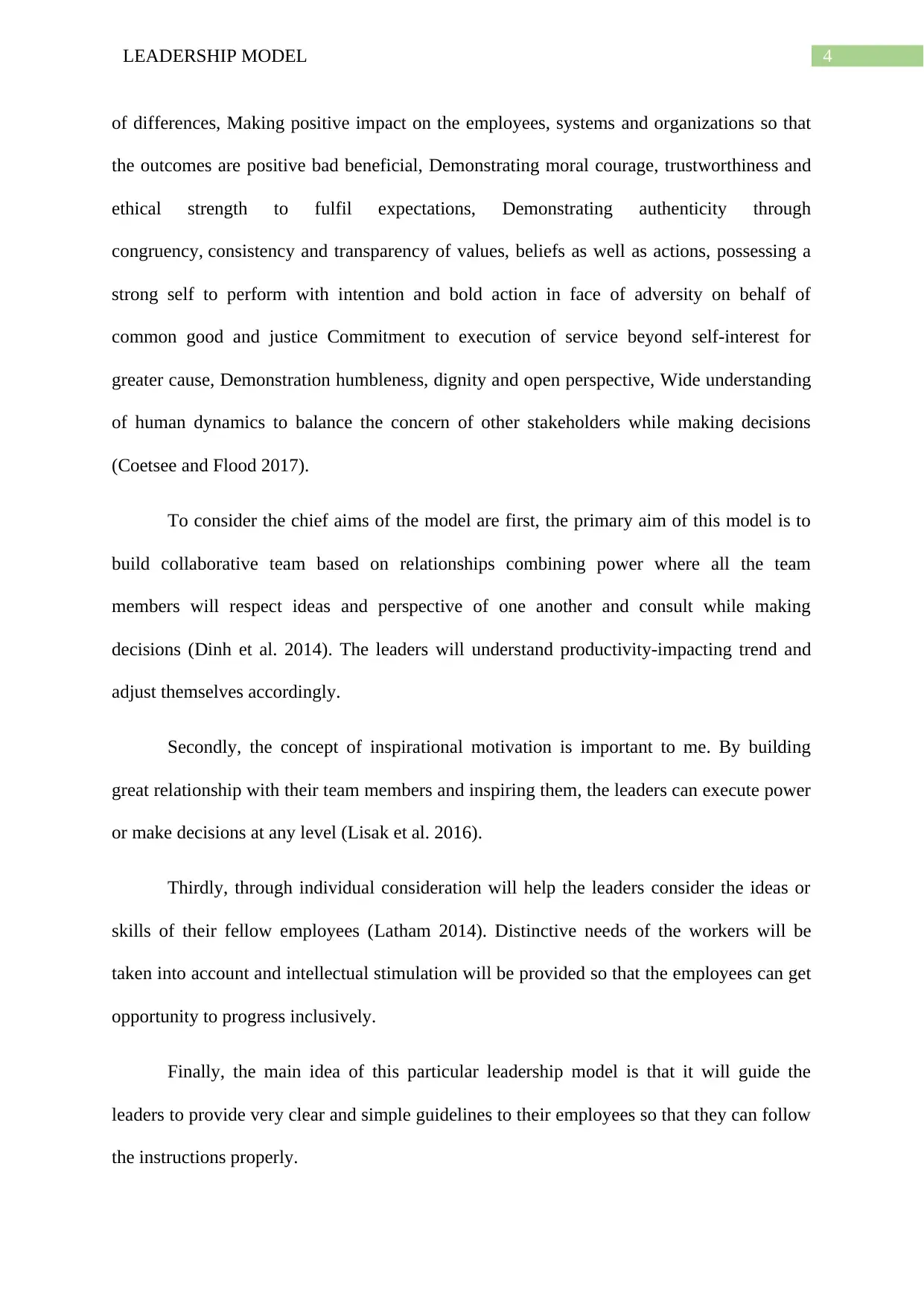
4LEADERSHIP MODEL
of differences, Making positive impact on the employees, systems and organizations so that
the outcomes are positive bad beneficial, Demonstrating moral courage, trustworthiness and
ethical strength to fulfil expectations, Demonstrating authenticity through
congruency, consistency and transparency of values, beliefs as well as actions, possessing a
strong self to perform with intention and bold action in face of adversity on behalf of
common good and justice Commitment to execution of service beyond self-interest for
greater cause, Demonstration humbleness, dignity and open perspective, Wide understanding
of human dynamics to balance the concern of other stakeholders while making decisions
(Coetsee and Flood 2017).
To consider the chief aims of the model are first, the primary aim of this model is to
build collaborative team based on relationships combining power where all the team
members will respect ideas and perspective of one another and consult while making
decisions (Dinh et al. 2014). The leaders will understand productivity-impacting trend and
adjust themselves accordingly.
Secondly, the concept of inspirational motivation is important to me. By building
great relationship with their team members and inspiring them, the leaders can execute power
or make decisions at any level (Lisak et al. 2016).
Thirdly, through individual consideration will help the leaders consider the ideas or
skills of their fellow employees (Latham 2014). Distinctive needs of the workers will be
taken into account and intellectual stimulation will be provided so that the employees can get
opportunity to progress inclusively.
Finally, the main idea of this particular leadership model is that it will guide the
leaders to provide very clear and simple guidelines to their employees so that they can follow
the instructions properly.
of differences, Making positive impact on the employees, systems and organizations so that
the outcomes are positive bad beneficial, Demonstrating moral courage, trustworthiness and
ethical strength to fulfil expectations, Demonstrating authenticity through
congruency, consistency and transparency of values, beliefs as well as actions, possessing a
strong self to perform with intention and bold action in face of adversity on behalf of
common good and justice Commitment to execution of service beyond self-interest for
greater cause, Demonstration humbleness, dignity and open perspective, Wide understanding
of human dynamics to balance the concern of other stakeholders while making decisions
(Coetsee and Flood 2017).
To consider the chief aims of the model are first, the primary aim of this model is to
build collaborative team based on relationships combining power where all the team
members will respect ideas and perspective of one another and consult while making
decisions (Dinh et al. 2014). The leaders will understand productivity-impacting trend and
adjust themselves accordingly.
Secondly, the concept of inspirational motivation is important to me. By building
great relationship with their team members and inspiring them, the leaders can execute power
or make decisions at any level (Lisak et al. 2016).
Thirdly, through individual consideration will help the leaders consider the ideas or
skills of their fellow employees (Latham 2014). Distinctive needs of the workers will be
taken into account and intellectual stimulation will be provided so that the employees can get
opportunity to progress inclusively.
Finally, the main idea of this particular leadership model is that it will guide the
leaders to provide very clear and simple guidelines to their employees so that they can follow
the instructions properly.
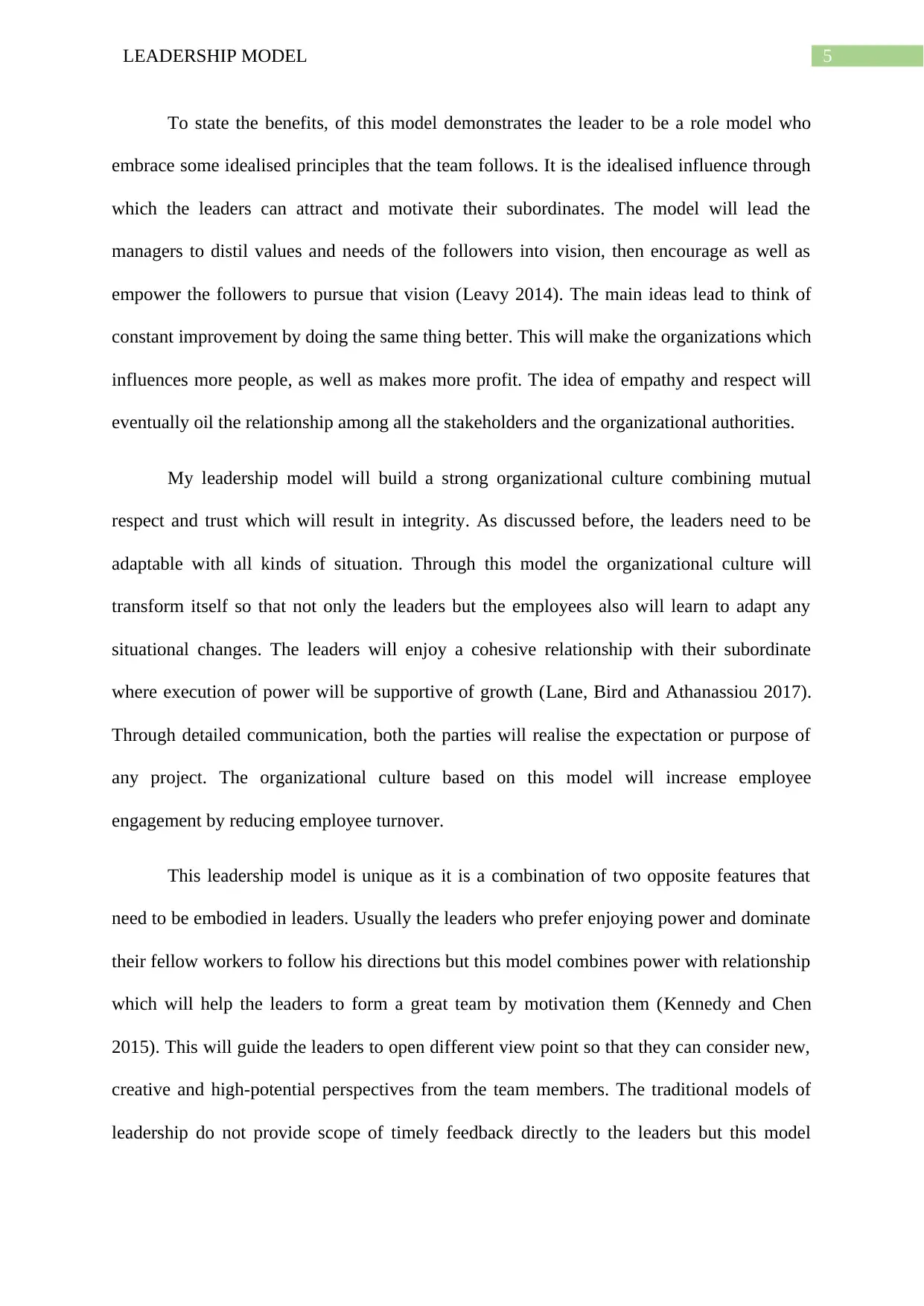
5LEADERSHIP MODEL
To state the benefits, of this model demonstrates the leader to be a role model who
embrace some idealised principles that the team follows. It is the idealised influence through
which the leaders can attract and motivate their subordinates. The model will lead the
managers to distil values and needs of the followers into vision, then encourage as well as
empower the followers to pursue that vision (Leavy 2014). The main ideas lead to think of
constant improvement by doing the same thing better. This will make the organizations which
influences more people, as well as makes more profit. The idea of empathy and respect will
eventually oil the relationship among all the stakeholders and the organizational authorities.
My leadership model will build a strong organizational culture combining mutual
respect and trust which will result in integrity. As discussed before, the leaders need to be
adaptable with all kinds of situation. Through this model the organizational culture will
transform itself so that not only the leaders but the employees also will learn to adapt any
situational changes. The leaders will enjoy a cohesive relationship with their subordinate
where execution of power will be supportive of growth (Lane, Bird and Athanassiou 2017).
Through detailed communication, both the parties will realise the expectation or purpose of
any project. The organizational culture based on this model will increase employee
engagement by reducing employee turnover.
This leadership model is unique as it is a combination of two opposite features that
need to be embodied in leaders. Usually the leaders who prefer enjoying power and dominate
their fellow workers to follow his directions but this model combines power with relationship
which will help the leaders to form a great team by motivation them (Kennedy and Chen
2015). This will guide the leaders to open different view point so that they can consider new,
creative and high-potential perspectives from the team members. The traditional models of
leadership do not provide scope of timely feedback directly to the leaders but this model
To state the benefits, of this model demonstrates the leader to be a role model who
embrace some idealised principles that the team follows. It is the idealised influence through
which the leaders can attract and motivate their subordinates. The model will lead the
managers to distil values and needs of the followers into vision, then encourage as well as
empower the followers to pursue that vision (Leavy 2014). The main ideas lead to think of
constant improvement by doing the same thing better. This will make the organizations which
influences more people, as well as makes more profit. The idea of empathy and respect will
eventually oil the relationship among all the stakeholders and the organizational authorities.
My leadership model will build a strong organizational culture combining mutual
respect and trust which will result in integrity. As discussed before, the leaders need to be
adaptable with all kinds of situation. Through this model the organizational culture will
transform itself so that not only the leaders but the employees also will learn to adapt any
situational changes. The leaders will enjoy a cohesive relationship with their subordinate
where execution of power will be supportive of growth (Lane, Bird and Athanassiou 2017).
Through detailed communication, both the parties will realise the expectation or purpose of
any project. The organizational culture based on this model will increase employee
engagement by reducing employee turnover.
This leadership model is unique as it is a combination of two opposite features that
need to be embodied in leaders. Usually the leaders who prefer enjoying power and dominate
their fellow workers to follow his directions but this model combines power with relationship
which will help the leaders to form a great team by motivation them (Kennedy and Chen
2015). This will guide the leaders to open different view point so that they can consider new,
creative and high-potential perspectives from the team members. The traditional models of
leadership do not provide scope of timely feedback directly to the leaders but this model
⊘ This is a preview!⊘
Do you want full access?
Subscribe today to unlock all pages.

Trusted by 1+ million students worldwide
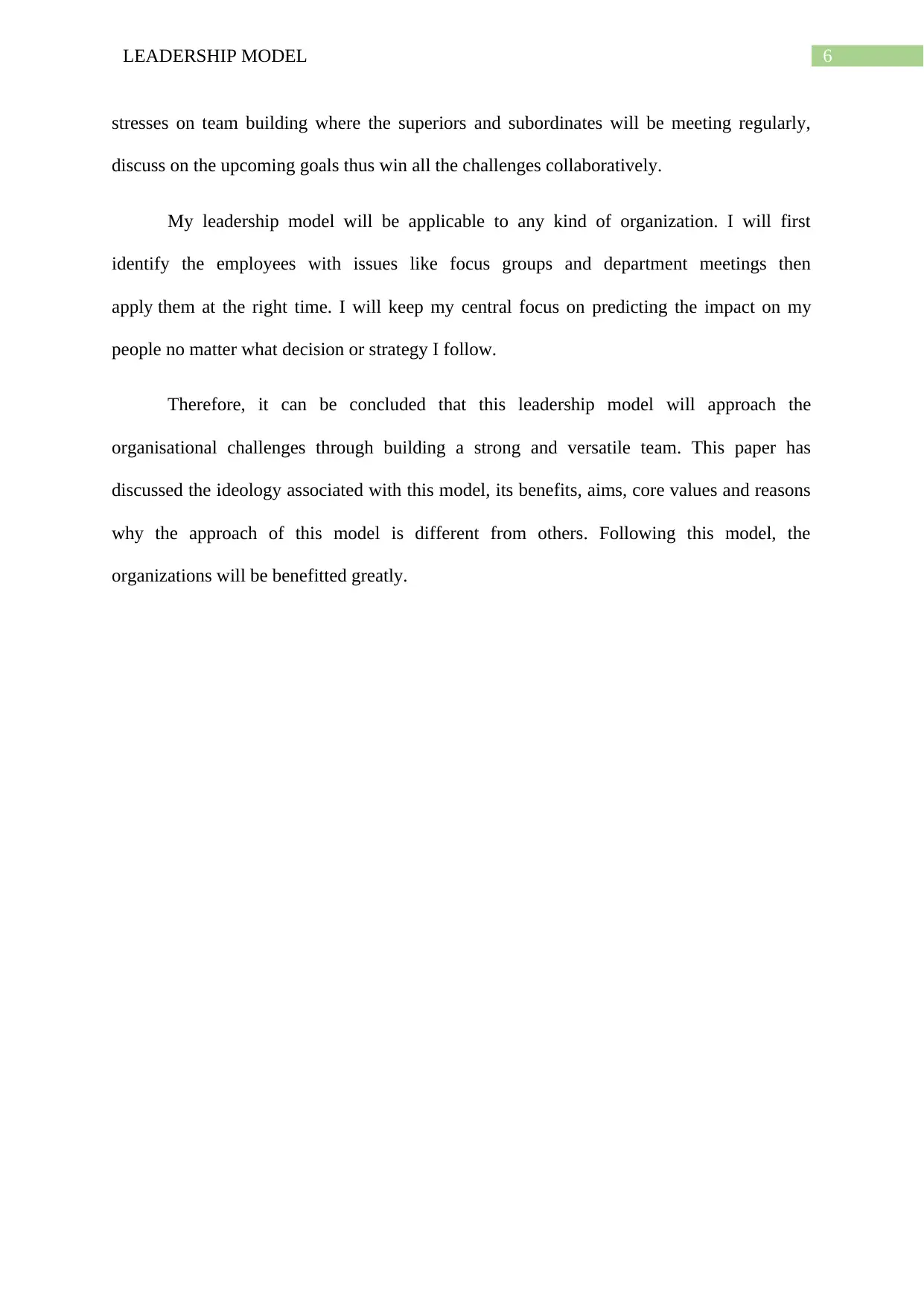
6LEADERSHIP MODEL
stresses on team building where the superiors and subordinates will be meeting regularly,
discuss on the upcoming goals thus win all the challenges collaboratively.
My leadership model will be applicable to any kind of organization. I will first
identify the employees with issues like focus groups and department meetings then
apply them at the right time. I will keep my central focus on predicting the impact on my
people no matter what decision or strategy I follow.
Therefore, it can be concluded that this leadership model will approach the
organisational challenges through building a strong and versatile team. This paper has
discussed the ideology associated with this model, its benefits, aims, core values and reasons
why the approach of this model is different from others. Following this model, the
organizations will be benefitted greatly.
stresses on team building where the superiors and subordinates will be meeting regularly,
discuss on the upcoming goals thus win all the challenges collaboratively.
My leadership model will be applicable to any kind of organization. I will first
identify the employees with issues like focus groups and department meetings then
apply them at the right time. I will keep my central focus on predicting the impact on my
people no matter what decision or strategy I follow.
Therefore, it can be concluded that this leadership model will approach the
organisational challenges through building a strong and versatile team. This paper has
discussed the ideology associated with this model, its benefits, aims, core values and reasons
why the approach of this model is different from others. Following this model, the
organizations will be benefitted greatly.
Paraphrase This Document
Need a fresh take? Get an instant paraphrase of this document with our AI Paraphraser
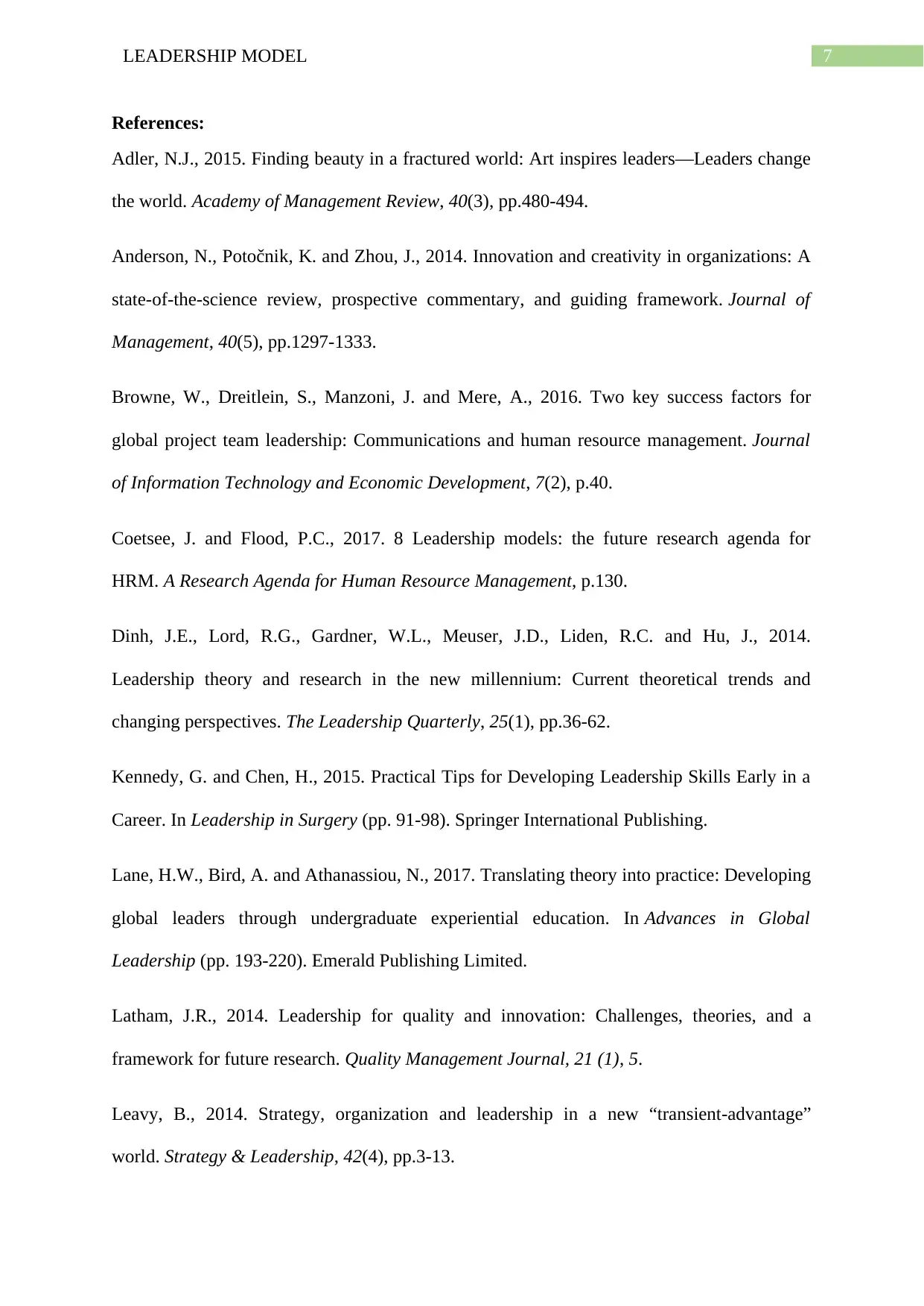
7LEADERSHIP MODEL
References:
Adler, N.J., 2015. Finding beauty in a fractured world: Art inspires leaders—Leaders change
the world. Academy of Management Review, 40(3), pp.480-494.
Anderson, N., Potočnik, K. and Zhou, J., 2014. Innovation and creativity in organizations: A
state-of-the-science review, prospective commentary, and guiding framework. Journal of
Management, 40(5), pp.1297-1333.
Browne, W., Dreitlein, S., Manzoni, J. and Mere, A., 2016. Two key success factors for
global project team leadership: Communications and human resource management. Journal
of Information Technology and Economic Development, 7(2), p.40.
Coetsee, J. and Flood, P.C., 2017. 8 Leadership models: the future research agenda for
HRM. A Research Agenda for Human Resource Management, p.130.
Dinh, J.E., Lord, R.G., Gardner, W.L., Meuser, J.D., Liden, R.C. and Hu, J., 2014.
Leadership theory and research in the new millennium: Current theoretical trends and
changing perspectives. The Leadership Quarterly, 25(1), pp.36-62.
Kennedy, G. and Chen, H., 2015. Practical Tips for Developing Leadership Skills Early in a
Career. In Leadership in Surgery (pp. 91-98). Springer International Publishing.
Lane, H.W., Bird, A. and Athanassiou, N., 2017. Translating theory into practice: Developing
global leaders through undergraduate experiential education. In Advances in Global
Leadership (pp. 193-220). Emerald Publishing Limited.
Latham, J.R., 2014. Leadership for quality and innovation: Challenges, theories, and a
framework for future research. Quality Management Journal, 21 (1), 5.
Leavy, B., 2014. Strategy, organization and leadership in a new “transient-advantage”
world. Strategy & Leadership, 42(4), pp.3-13.
References:
Adler, N.J., 2015. Finding beauty in a fractured world: Art inspires leaders—Leaders change
the world. Academy of Management Review, 40(3), pp.480-494.
Anderson, N., Potočnik, K. and Zhou, J., 2014. Innovation and creativity in organizations: A
state-of-the-science review, prospective commentary, and guiding framework. Journal of
Management, 40(5), pp.1297-1333.
Browne, W., Dreitlein, S., Manzoni, J. and Mere, A., 2016. Two key success factors for
global project team leadership: Communications and human resource management. Journal
of Information Technology and Economic Development, 7(2), p.40.
Coetsee, J. and Flood, P.C., 2017. 8 Leadership models: the future research agenda for
HRM. A Research Agenda for Human Resource Management, p.130.
Dinh, J.E., Lord, R.G., Gardner, W.L., Meuser, J.D., Liden, R.C. and Hu, J., 2014.
Leadership theory and research in the new millennium: Current theoretical trends and
changing perspectives. The Leadership Quarterly, 25(1), pp.36-62.
Kennedy, G. and Chen, H., 2015. Practical Tips for Developing Leadership Skills Early in a
Career. In Leadership in Surgery (pp. 91-98). Springer International Publishing.
Lane, H.W., Bird, A. and Athanassiou, N., 2017. Translating theory into practice: Developing
global leaders through undergraduate experiential education. In Advances in Global
Leadership (pp. 193-220). Emerald Publishing Limited.
Latham, J.R., 2014. Leadership for quality and innovation: Challenges, theories, and a
framework for future research. Quality Management Journal, 21 (1), 5.
Leavy, B., 2014. Strategy, organization and leadership in a new “transient-advantage”
world. Strategy & Leadership, 42(4), pp.3-13.
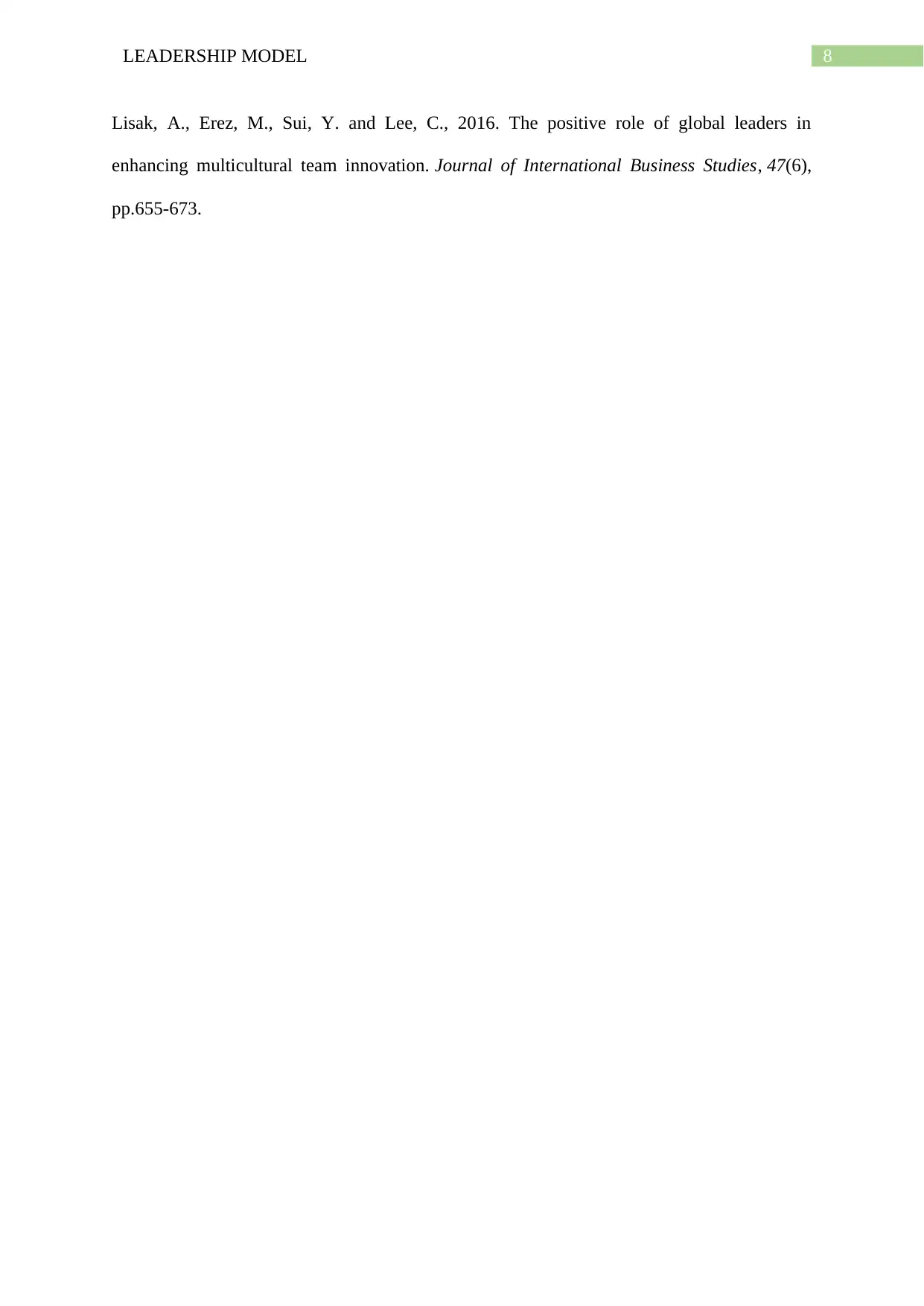
8LEADERSHIP MODEL
Lisak, A., Erez, M., Sui, Y. and Lee, C., 2016. The positive role of global leaders in
enhancing multicultural team innovation. Journal of International Business Studies, 47(6),
pp.655-673.
Lisak, A., Erez, M., Sui, Y. and Lee, C., 2016. The positive role of global leaders in
enhancing multicultural team innovation. Journal of International Business Studies, 47(6),
pp.655-673.
⊘ This is a preview!⊘
Do you want full access?
Subscribe today to unlock all pages.

Trusted by 1+ million students worldwide
1 out of 9
Related Documents
Your All-in-One AI-Powered Toolkit for Academic Success.
+13062052269
info@desklib.com
Available 24*7 on WhatsApp / Email
![[object Object]](/_next/static/media/star-bottom.7253800d.svg)
Unlock your academic potential
Copyright © 2020–2025 A2Z Services. All Rights Reserved. Developed and managed by ZUCOL.




